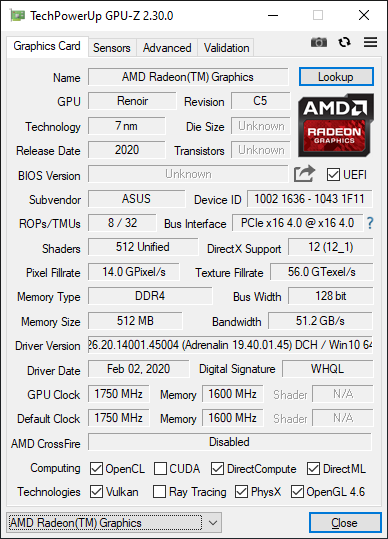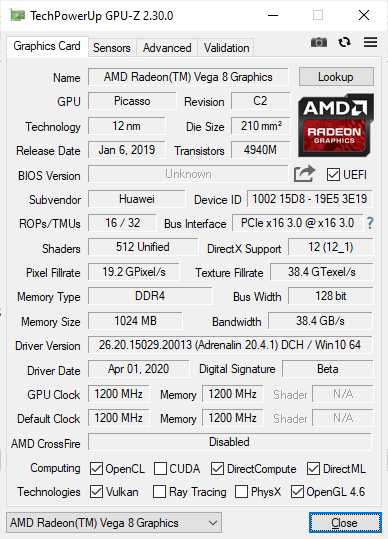AMD’s Mobile Revival: Redefining the Notebook Business with the Ryzen 9 4900HS (A Review)
by Dr. Ian Cutress on April 9, 2020 9:00 AM ESTTesting the Ryzen 9 4900HS Integrated Graphics
Under the hood of the Ryzen 9 4900HS, aside from the eight Zen 2 cores, is an enhanced Vega 8 graphics solution. For this generation of mobile processors, AMD is keeping the top number of compute units to 8, whereas in the previous generation it went up to Vega 11. Just by the name, one would assume that AMD has lowered the performance of the integrated graphics. This is not the case.
For the new Ryzen Mobile 4000 processors, the Vega graphics here are enhanced in three main ways over the previous generation. First is that it is built on the 7nm process node, and AMD put a lot of effort into physical design, allowing for a more optimized version that has a wider voltage/frequency window compared to the previous generation. Secondly, and somewhat connected, is the frequency: the new processors top out at 1750 MHz, rather than 1400 MHz, which would naturally give a simple 25 % boost with all other things being equal. Third on the list is memory, as the new platform supports up to DDR4-3200, rather than DDR4-2400, providing an immediate bandwidth boost which is what integrated graphics loves. There’s also the nature of the CPU cores themselves, having larger L3 caches, which often improves integrated graphics workloads that interact a lot with the CPU.
Normally, with the ASUS Zephryus G14, the switching between the integrated graphics and the discrete graphics should be automatic. There is a setting in the NVIDIA Control Panel to let the system auto-switch between integrated and discrete, and we would expect the system to be on the IGP when off the wall power, but on the discrete card when gaming (note, we had issues in our battery life test where the discrete card was on, but ASUS couldn’t reproduce the issue). In order to force the integrated graphics for our testing, because the NVIDIA Control Panel didn’t seem to catch all of our tests to force them onto the integrated graphics, we went into the device manager and actually disabled the NVIDIA graphics.
This left us with AMD’s best integrated graphics in its Ryzen Mobile 4000 series: 1750 MHz of enhanced Vega 8 running at DDR4-3200.

Renoir with Vega 8 – updated to 20.4 after this screenshot was taken
Our comparison point here is actually a fairly tricky one to set up. Unfortunately we do not have a Ryzen 7 3750H from the previous generation for comparison, but we do have an Honor Magicbook 14, which has a Ryzen 5 3500U.
This is a 15 W processor, running at 1200 MHz and DDR4-2400, which again makes the comparison a little tricky, but it is better than comparing it to the Intel HD630 graphics in the Razer Blade.
We also re-ran the benchmarks on the latest drivers with AMD's 65 Desktop APUs, the Ryzen 5 3400G (with Vega11) and the Ryzen 3 3200G (with Vega 8). These are running at DDR4-2933, the AMD maximum officially supported by these APUs (which means anything above this is overclocking).


This is a pretty substantial difference, no joke.



Hopefully we will get more variants of the Ryzen integrated graphics to test, along with an Ice Lake system.











267 Comments
View All Comments
Zingam - Saturday, April 11, 2020 - link
How is the triple monitor 4K support? Is triple 4K monitor setup viable? Is it smooth? Does it lag? Does it overheat? Does it make the fans howl all the time even while idling? Does it have driver issues?Can I connect this laptop or any other modern laptops to two (or more if supported) K4 external monitors for a three monitor setup and type, edit text, compile code and never ever experience overheating, fan noise, lag and stuttering? Is this APU a good work driver? This type of tests I am interested in!
And I also like to know how it compares to older CPUs not just the current. I like to know how it compares to Sandy Bridge, to Sky Lake, to Kaby Lake i7 -7700HQ, etc with and without discrete GPU (1050Ti) to know if an upgrade is worth it.
I don't care about battery life very much but I care about performance, heat and fan noise and how portable that setup is. I don't work in coffee shops but I need to carry my laptop from my office to my home and back on my back - so I care about it being light with a small power brick too.
It is very rarely that reviews provide that information - it is all about gaming and flashiness.
Zingam - Saturday, April 11, 2020 - link
@Ian it would be great if you compare these new CPUs to older for real work professional use and even with other small form factor PCs like the NUCs and the Mac Minis.Zingam - Saturday, April 11, 2020 - link
Can it run a 2-3 hour compilation or static analysis without throttling, while watching YouTube, running an emulator and browsing the web, which is just as important as not throttling while gaming or running a game in the background while debugging it in the summer season. :)Viilutaja - Saturday, April 11, 2020 - link
I have not used any of my laptops webcams ever! And i have used work laptops (Lenovo Thinkpads) for some time now. Right now i have special cover on my laptop webcam and have not opened it since installation. I have weekly meetings with collaegues and many other meetings with clients, never ever was the webcam on. Overrated part in laptops. Who has a need to do video converences, that person buys separate 4k60fps external webcam for it anyway.nils_ - Saturday, April 11, 2020 - link
I would like this very much in a mobile workstation, but I do need Thunderbolt 3 at least for my Docking Station. I can do without the dGPU.dk404 - Saturday, April 11, 2020 - link
+1 AMD for their focus on perf per watt, more design per socket plus perf per $ (value). They definitely leading the innovation for laptop, desktop and also server markets,...Now time for blue to wake up even though it's too late,...
SeanFL - Saturday, April 11, 2020 - link
Wondering how long before we see some ultra tiny desktops using the new AMD laptop APU's, similar to the NUC, Lenovo Thinkcentre, or the HP Elitedesk. The aforementioned systems are great for almost anything except video editing. The new 4000 series chips would be fantastic in a tiny desktop. Please AMD.realbabilu - Saturday, April 11, 2020 - link
Is it hackintoshable ?I wish apple also see amd as a switch too
Dodozoid - Saturday, April 11, 2020 - link
Awesome review Dr. Cutress. There are two points that interest me. First - GPU Z shows the iGPU connected via PCIe 4.0 16x. Are there any power/performance implications to that or is it simply misinterpretation of infinity fabric?And another one is regarding the on-battery performance. There is an important piece of information missing (I am aware you show part of in in battery life section)- how long does it maintain that performance?
(And maybe how much influence do various power/performance setting have on the the framerates/endurance tradeoffs?)
phoenix_rizzen - Sunday, April 12, 2020 - link
Renoir doesn't have PCIe 4. That should say PCIe 3 x8 for the GPU.